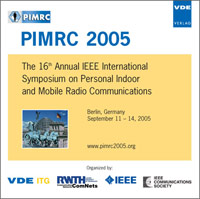Modeling Synchronous Wakeup Patterns in Wireless Sensor Networks: Server Vacation Model Analysis
Conference: PIMRC 2005 - 16th Annual IEEE International Symposium on Personal Indoor and Mobile Radio Communications
09/11/2005 - 09/14/2005 at Berlin, Germany
Proceedings: PIMRC 2005
Pages: 5Language: englishTyp: PDF
Personal VDE Members are entitled to a 10% discount on this title
Authors:
Lau, K. M.; Yue, OnChing (Information Engineering Department, The Chinese University of Hong Kong, Shatin, N.T., Hong Kong)
Abstract:
Power-saving in wireless sensor networks is very crucial since most of the wireless sensors are battery-operated. Turning the sensor nodes into a low-power sleep state periodically is an important technique to conserve energy and prolong network lifetime. However, putting the sensor nodes into the sleep state will result in increased message latency. In this paper, we aim at developing a framework for modeling the synchronous wakeup patterns of networked sensors so as to provide a basis for studying such design tradeoff. The proposed framework employed the vacation model from queueing theory to model the synchronous wakeup patterns as an M/G/1 queue with server vacations. Based on the model, the optimal operation scenario for the synchronous wakeup operation is first deduced. We then make use of the model to study the synchronous wakeup patterns with exhaustive and gated services disciplines in particular. Analytical results for these two wakeup patterns are derived and summarized in this paper.


